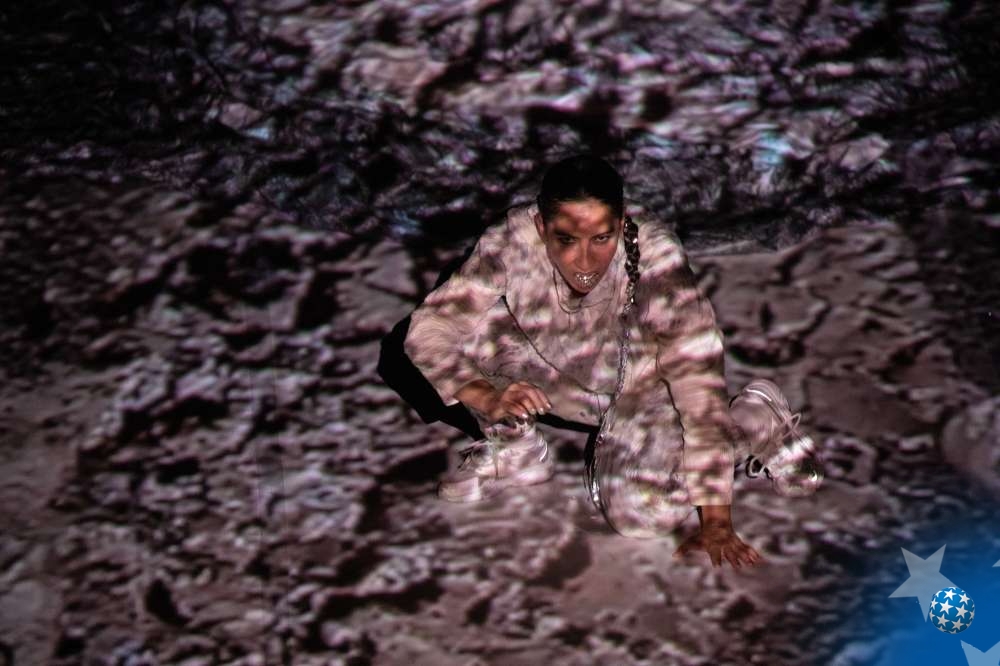The performance Climatic Dances is a part of the fifth volume of your big project Endangered Human Movements. Which topics have you tackled throughout this project and what made you opt for this form of work?
- I decided to work in volumes so that I don’t have to create new pieces all the time, while I can still stay with the same idea of research that I could deepen. This is volume five, which has to do with relations with mountains, with bodies of water, with what western modern colonial language calls nature and which for some other people or other beings, represents life or what sustains it. This piece is somehow about my mother too, because she lives in a place endangered by the extraction conducted by mining corporations, which uses a lot of water, pollutes the area, and dries up the sources that the city and communities in the region where my mother lives rely on. It’s very much about mining exploitation and about how dance and art deal with those issues today. I know that you in Serbia have Rio Tinto project expanding, so we are devoted to the same effort - not to be against those corporations, but against their way of thinking which allows exploitation, and devaluation of people’s quality of life.
How do parts of this projects communicate and create one body of work?
- They stem from the same research but communicate in different formats. Sometimes they are museum exhibitions, sometimes turned into a movie, sometimes, like here, theatre performance. Sometimes they are expressed through a piece of writing since I write about the research and its results. So yes, they communicate but also deepen the questions posed by the research in different formats.
You use your work to tackle the issues of endangered biological and cultural diversity, erasing the difference between culture and nature? How is that possible?
- I think that the division between culture and nature comes from a very modern colonial western anthropocentric worldview. In other settings, and in many other forms of thought, people don’t have this idea. Many nations nurture a concept according to which everything - animals, plants, and even mountains - can be persons, and have a body. In western modern colonial concept, the only ones who have a body are animals and humans and that is a point of view which leads to objectification - everything that is not a human is an object that I can exploit. That is only one worldview, while there are many others, and the problem is when western modern colonial thought expands through violence, and you here know that too, because we both come from contexts which have been violated by their attempt to erase these other forms of thinking and existing. My work is, therefore, about being rebellious against that one world which I find very reductive. And I also don’t like the premises that it relies on, since they are not trying to create a good life. We live in the world which is focused on the growth, but the growth of a very small part of that world.
Your first contact with dance happened during anti-government protests in Chile, which means that, for you, dance has always been connected to social and political struggle. Can it be different?
- We can’t call the protest anti-government because it wasn’t a government, it was a dictatorship. Yes, there was social dancing there, there was jumping. And then when Mapuche tribe did the same kind of jumping, I understood that we are much more connected than we thought. Every dance is political. I think art always has a political context and I like to highlight that.
This Bitef goes under the slogan Edge of the Future. How do you understand that?
- Future…this asks for a long answer because in western modern colonial concepts temporality is seen as a line. But time is not a line because time is not a spatial dimension. And that line of theirs is very violent. We spend so little time thinking about our ancestry, and about other concepts of time. That is why the future is a difficult one. We are living in the moment when the young people who I work with don’t have any sense of the future, because of the whole collapse of the environment, it is questionable what kind of conditions they are going to live in. It’s scary. So, I think that future are many futures, and I hope so for that.

